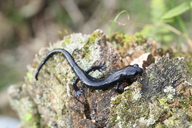|
Bolitoglossa meliana Wake & Lynch, 1982
Subgenus: Magnadigita | family: Plethodontidae subfamily: Hemidactyliinae genus: Bolitoglossa |
 © 2008 Sean Michael Rovito (1 of 16) |
|
|
Country distribution from AmphibiaWeb's database: Guatemala
Author: Jean Raffaëlli
Bolitoglossa (Magnadigita) meliana Wake & Lynch, 1982
Grande forme uniformément noire, mâle beaucoup plus petit que la femelle. 6,6 cm SVL (M), 8,8 cm SVL (F). Extrémités des doigts et orteils tronquées, palmure faible, queue plus courte que le reste du corps, épaisse et fortement comprimée à la base. Deux espèces, selon Highton (in Bruce, 2000), l’une des populations ayant une distance génétique atteignant Nei D = 0,26 à 0,31 par rapport aux autres populations (voir B. psephena). * Six localités sur 160 km de longueur dans les montagnes du Guatemala central, dont les Sierras de Chuacus et de Las Minas, entre 1 550 et 2 730 m. En forêt de brume et forêts mixtes pins/chênes, parfois à la lisière de la forêt, mais absent des zones dégradées. Sous des écorces, souches à terre et dans les broméliacées. EN. Présent dans le parc national de la Sierra de Las Minas et sur le biotope universitaire Mario Dary Rivera, qui offrent une certaine protection. From Les Urodèles du Monde, 1e edition, 2007: Bolitoglossa (Magnadigita) meliana Wake et Lynch, 1982 Grande forme uniformément noire, mâle beaucoup plus petit que la femelle. 8,8 cm SVL. Extrémités des doigts et orteils tronquées, palmure faible, queue plus courte que le reste du corps, épaisse et fortement comprimée à la base. Deux espèces, selon Highton (in Bruce, 2000), l’une des populations ayant une distance génétique atteignant Nei D = 0,26 à 0,31 par rapport aux autres populations. Six localités sur 160 km de longueur dans les montagnes du Guatemala central, y compris dans les Sierras de Chuacus et de Las Minas, entre 1 550 et 2730 m. En forêt de brume et forêts mixtes pins/chênes, parfois à la lisière de la forêt, mais absente des zones dégradées. Sous des écorces, souches à terre et dans les broméliacées. 2 189 km2. EN. Présente dans le parc national de la Sierra de Las Minas et sur le biotope universitaire Mario Dary Rivera, qui offrent une certaine protection.  ENGLISH TRANSLATION - Julian
Wittische,
December 2011 ENGLISH TRANSLATION - Julian
Wittische,
December 2011
Bolitoglossa melianais a big species, and is entirely black. Males are shorter than females. The species has a SVL of 8.8 cm. The extremities of the fingers and toes are truncated, with light webbing. The tail is shorter than the rest of the body, thick and highly compressed at its base. Two species according to Highton (in Bruce, 2000). One of the populations has a genetic distance reaching Nei D=0.26 to 0.31 compared with other populations. Habitat & Range: B. meliana lives in six localities over a length of 160 km in the mountains of central Guatemala, including the Sierras de Chuacus and de Las Minas, between 1550 m and 2730 m. It lives in cloud and mixed pine/oak forests, sometimes on the edge of the forest, but is absent in altered zones. It can be found under bark and trunks which are on the ground, and in bromeliads. 2189 km². Conservation:
Its status is considered Endangered. B. meliana is present in the Sierra de
Las
Minas National Park and in the Mario Dary Rivera University Biotope, that offer
medium
protection.
Feedback or comments about this page.
Citation: AmphibiaWeb. 2025. <https://amphibiaweb.org> University of California, Berkeley, CA, USA. Accessed 1 Apr 2025. AmphibiaWeb's policy on data use. |



 Raffaëlli Account
Raffaëlli Account Map of Life
Map of Life